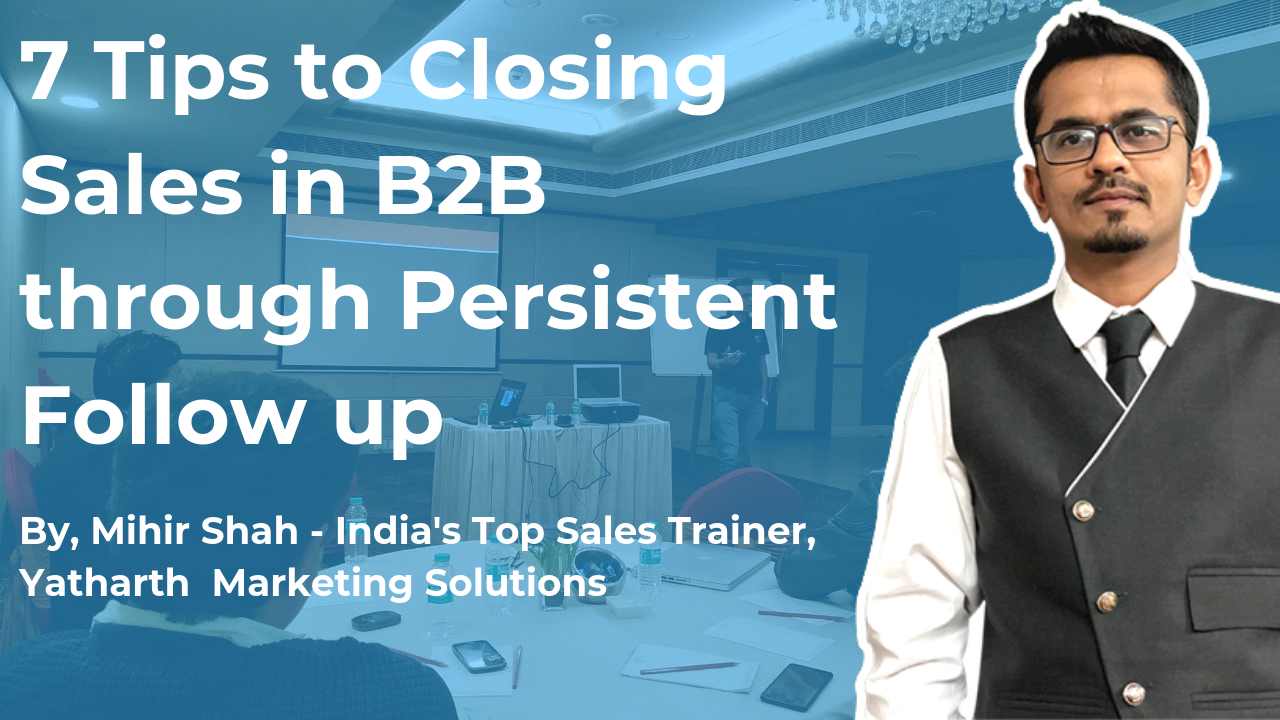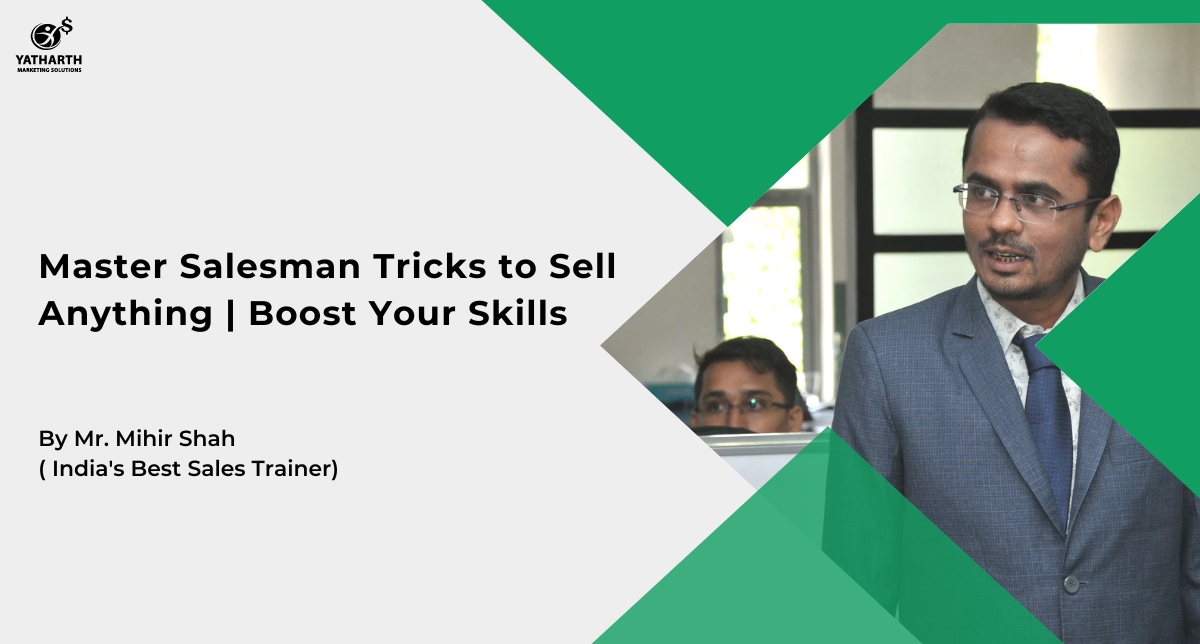Sales trainers in India usually position the first meeting as a make or break event, where the deal will be signed and all matters discussed. However, the reality is a bit different. More often than not, there are a lot of attempts to negotiate a successful deal, to interact with all the stakeholders, and finalize the details. This is especially true of B2B sales that take longer and involve more steps.
Most of us as salespeople would hesitate to do a persistent follow-up. Usually, this is because we feel that we might be interrupting the prospect’s day which might just drive away from the sale. Obviously, repeated contact might seem like harassment, and it is important to be aware of how you are coming across. But persistence is the bread and butter for salespeople, who cannot afford to ignore any leads. You will have to follow up as many times as necessary to get the final response. The lead may have failed to convert, but it is important to confirm the status before you close it. Remember, according to research, only about 2% of initial meetings are closed successfully. That is why you have to have a strong follow-up game to try and convert more leads.
When you have a lead, your responsibility is not limited to checking in with them regularly. That is a surefire way to completely ignore the potential. Sales training research in India shows that following up is not only about reminding them to respond to you. Your follow-up strategy should be about highlighting different aspects of value you are offering with every connection. You might want to talk about the time you will be saving on your second attempt, and draw their attention to the ease of deployment in the next communication.
There are many tips out there for a successful follow-up. Most of them are sensible and effective, but here are some of the fundamental ways of creating a strong follow-up strategy.
1. Consider the right channel for reaching out to your prospect
Organizations have different first approaches to potential clients. Some may want to do it over a formal, informative email while others might want to just pick up the phone and call to speak. Depending on the industry and its practices, companies will choose whichever is more effective for the initial contact.
Emails certainly have some advantages such as that they provide an opportunity for the receiver to deliberate on the message before responding. However, the first email to a prospect has very poor chances of attracting attention. Unless it is accompanied with a great subject line and information completely customized for the recipient. You may have to send multiple emails to grab attention.
Calling the prospect directly might seem like a better option but it is not necessarily true. People are wary about cold calls and may not answer on the first attempt. These days companies may not use landlines either so it may not be possible to directly reach the organization. There are greater chances of scheduling a follow-up call but you have to be really persuasive to make an impact.
You should also consider the less traditional methods of reaching out such as social media. An informal setting can considerably help you establish a rapport with the prospect. This does not have to directly be about making a sale but rather about entering the attention of the audience. A good salesperson will also try to establish a connection through his own network of contacts. Everyone will be more open to trusting a known connection rather than a cold call so this approach has a higher success rate.
There is, of course, no one right way to go about the setting up the first contact. Ideally, you should choose one primary method of contact and then complement it with the other lines. For example, an introduction email with a telephone call after a day while also reaching out through social media and referrals.
2. Craft a Persuasive Subject line for your emails
We receive hundreds of commercial email during any month. It would be impossible for us to go through every single one of them individually, and most of them are destined to stay in our inboxes or trash without ever seeing the light of the day.
You should remember this when you are emailing prospects for meetings. You have to stand out from literally hundreds of competitors which are the commercial emails. The most effective way to accomplish that is to stand out with an absolutely relevant subject line.
Choose between short and shocking or create a long subject line that deliberately provokes action from the recipient. Change the subject line as often as you can and try to keep it relevant to the receiver. Another trick could be to study what your competitors are doing and your subject line should highlight where you are better than them.
3. Nurture Every Lead
There is an assumption that salespeople are only trying to close deals. They are more interested in getting the prospect to sign up rather than helping them find solutions. This is more common than you think, since sales training in India often focuses on this. So how can you stand out from the crowd that is following this blindly?
You should treat every lead as a relationship opportunity and communicate accordingly. Potential clients want to talk to salespeople who can answer their questions and understand their concerns. You have to be that person. When you nurture leads by helping them, and not pressing for closure every single time, you build trust that will close the deal for you. Potential customers will invariably not sign up on the first contact. Instead of just following up with prospects for updates, you should help them with their requirements which will help close sales.
4. Best Timing for Follow Up
There is a lot of suggestions on the internet about the strict timings to follow for an assured deal. This is obviously not true. There is no magic formula for following up with prospects. Just a few tips on improving your chances of engaging with the prospect. Ideally, you should be more persistent in the beginning and reduced attempts if there is no response. For example, you can reach a prospect on phone and email, reach out on social media, approach through referrals, etc. But chart out a specific timeline to follow on how you will approach your prospects at their convenience. Remember, not every contact has to be about closing the deal. Rather, it is about nurturing your lead to a closed deal.
5. What to say during the follow-up
When you communicate with a prospect, the tone you use is crucial in establishing you as either a potential business partner or an annoying salesman. Every time you call or mail a prospect, have something of value to share. It can be as simple as letting them know of a new offer or the effect of a recent regulation that can help you deliver faster. There is no point in calling them if you just want to check up on them. Talk to them about them, not you. You should identify their pain points and address these issues in pitching for your product. Please understand their priorities and motivations so you can help them better. If you can come up with insights on helping their business, you should share them. You can also share relevant content to them such as business papers or ebooks, or even news that they might not want to miss out on.
6. Establish an agreement with the prospect about follow up
At any chance you get to interact with the potential client, it is a good idea to get a commitment from them regarding a follow-up. Establish the lines of communication that you will pursue to follow up, such as calling their secretary or having a call on a particular day and time. They might not agree to it, but you can still let them know when they can expect a call from you about further discussion. This actually commits them to listen to your pitch so they can be ready for the follow-up. Please remember that this is to be done tactfully rather than forcefully. Look for an opportunity to request for a follow-up, and assure them something of value they can receive at the follow-up meeting
7. Deliver on your promises
Even if a prospect seems uninterested at first, it is not an excuse to be sloppy in your follow up. If you say you will send them a brochure tonight, then whether they receive that brochure or no will determine the rest of your engagement. They take time to commit to a sale with you so they can confirm that you are reliable. Instances, where you promise something and do not deliver, is a sign that they cannot trust you. If they are unavailable or do not respond, you should still deliver what you promised. Send the proposal as you promised. If you assured them that you will find a solution, you should give them an update at that time.


